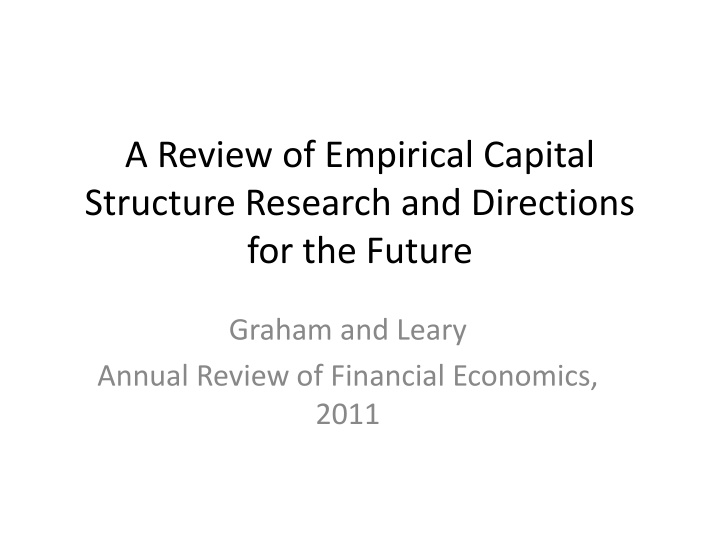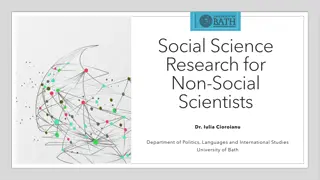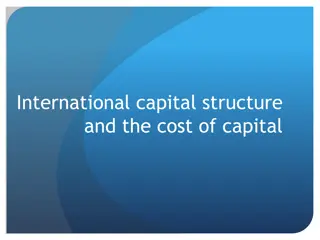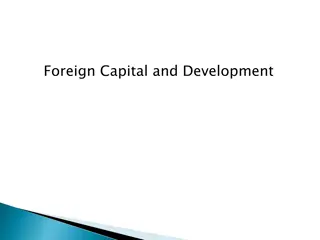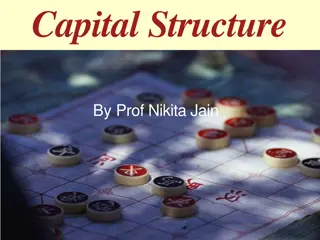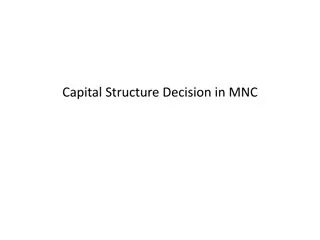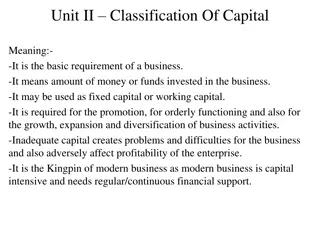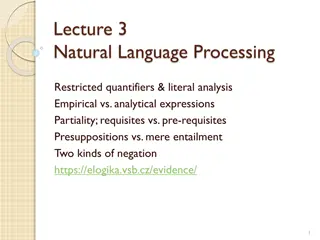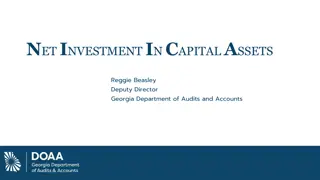Empirical Capital Structure Research: Key Insights and Challenges
This review explores classic capital structure theories, critiques prior research problems, and examines firm characteristics and leverage variation. It delves into the trade-off theory focusing on within-firm variation, highlighting discrepancies in profitability-leverage relationships. The study emphasizes the need for a comprehensive consideration of financial factors impacting capital structures.
Download Presentation

Please find below an Image/Link to download the presentation.
The content on the website is provided AS IS for your information and personal use only. It may not be sold, licensed, or shared on other websites without obtaining consent from the author.If you encounter any issues during the download, it is possible that the publisher has removed the file from their server.
You are allowed to download the files provided on this website for personal or commercial use, subject to the condition that they are used lawfully. All files are the property of their respective owners.
The content on the website is provided AS IS for your information and personal use only. It may not be sold, licensed, or shared on other websites without obtaining consent from the author.
E N D
Presentation Transcript
A Review of Empirical Capital Structure Research and Directions for the Future Graham and Leary Annual Review of Financial Economics, 2011
Classic Capital Structure Theories Trade off theory: There is an optimal capital structure that balances various costs and benefits of debt (MM1958) Pecking order theory: firms follow a financing hierarchy designed to minimize adverse selection costs of security issuance (Myers and Majluf (1984))
Problems in Prior Studies 1. Important dependent and explanatory variables have been mis-measured. 2. The impact of leverage on non-financial stakeholders is important. 3. The supply side of capital affects corporate capital structures. 4. Richer features of financial contracts should be considered and add new dimensions to study. 5. Value effects due to capital structure variation are modest over wide ranges of leverage 6. Estimates of leverage adjustment speeds are biased. 7. The implications of capital structure dynamics have not been adequately considered.
Table 1: Firm Characteristics and Capital Structure
Summary of Table 2 There is more cross-sectional variation than within-firm variation Most of the cross-sectional variation is within industries as opposed to across industries Within-industry variation has increased over time. Standard proxies best explain variation across industries, but struggle to explain variation within firms. The ability of standard proxies to explain leverage variation has declined over time, particularly for within-industry variation.
Trade off Theory Focusing on within-firm variation, the tradeoff view is that deviations from optimal leverage are costly and should be corrected. However, the negative relation between profitability and leverage appears inconsistent with the tradeoff model because, all else equal, more profitable firms should more highly value the tax-shield benefits of debt. they explain relatively little of the observed capital structure variation. the rate of mean reversion to target is too slow to be considered a first-order policy determinant
Pecking Order Theory The pecking order view suggests that the adverse selection costs of issuing equity are large enough to render other costs and benefits of debt and equity second-order. This implies financial slack is valuable and predicts a financing hierarchy in which mature firms with limited growth prospects finance investments first out of internal funds, then with debt, and issue equity only as a last resort. The promise of this view lies in its consistency with two empirical regularities: (i) there is a significant negative market reaction to the announcement of seasoned equity issues; and (ii) in aggregate, firms fund the majority of investments with retained earnings while aggregate net equity issues are often small or even negative. while the pecking order may be a useful conditional theory , like the tradeoff view it leaves many financing decisions unexplained.
Improvements in Cross-Sectional Studies of Capital Structure I Variables mis-measurement proxy for leverage Distress costs Tax shields
Improvements in Cross-Sectional Studies of Capital Structure II Non-financial stakeholders employees Customers Suppliers Labor bargaining power
Improvements in Cross-Sectional Studies of Capital Structure III Supply effects capital structures are determined solely by corporate demand for debt. This prevailing view is questionable capital market segmentation and supply conditions significantly influence observed financial structures Credit supply: between bank-dependent firms and those with access to arms-length lenders. Shocks to supply curve
Improvements in Cross-Sectional Studies of Capital Structure III Supply effects I Equity market timing The first is that managers attempt to exploit deviations of security prices from fundamental value Secondly, if adverse selection costs are negatively correlated with market returns, the cost of equity issuance identified by Myers and Majluf (1984) may be lower when prices are high Supply-driven equity issuance activity is relevant for time- series changes in capital structure It becomes relevant for cross-sectional leverage ratios only if the capital structure effects are persistent.
Improvements in Cross-Sectional Studies of Capital Structure III Financial constraints go beyond just studying leverage ratios and focus on more detailed features and types of financing contracts, such as covenants, maturity, leasing, and the potential for renegotiation. Collateral and asset redeployability Leverage ratio Financing costs Debt maturity Leasing Constraining managers: covenants and renegotiation Incentive conflicts often arise as a firm becomes distressed.
Improvements in Cross-Sectional Studies of Capital Structure IV Are Value Effects Large Enough to Affect Capital Structure Choices? the contribution to firm value of optimal capital structure choices is moderate for most firms; the importance of capital structure tradeoffs may be modest over wide ranges of leverage choices. While large deviations from optimal may be costly, there may be little incentive for companies with moderate leverage to frequently optimize capital structure policy many firms will not carefully optimize capital structure each period
Improvements in Cross-Sectional Studies of Capital Structure IV Are Value Effects Large Enough to Affect Capital Structure Choices? Does capital structure reflect managers personal preferences? - Such as inside debt certain compensation packages may give managers incentive to take on risk, while others may discourage risk. Short term debt, which can be used to attenuate the incentive to take on risk, is more prevalent in risky settings, and less prevalent in low risk settings.
Improvements in Time-Series Studies of Capital Structure firms actual leverage may deviate from optimal due, due to shocks to asset values or short-term market timing opportunities. Evidence: firms respond slowly to deviations between actual and target leverage, so firms do not actively manage leverage toward a target
Estimated leverage adjustment speeds all the estimates from techniques designed to address the aforementioned bias fall within the 10% 40% range provided by OLS and fixed-effects estimates.
Dynamic Tradeoff Models Dynamic policy in the presence of costly restructuring there is not an optimal level of leverage, but an optimal range. Firms are inactive with respect to capital structure as long as leverage stays within that range and only make adjustments when leverage hits an upper or lower recapitalization bound
Dynamic Tradeoff Models Costly adjustment model - Leary and Roberts (2005) a model that produce a negative correlation between leverage and profitability, a large effect of recent stock returns, and slow mean reversion. First, firms make lumpy capital structure adjustments, on average once every four quarters Second, the conditional probability of a given adjustment in the next period is a moderately decreasing function of the time since the last adjustment Third, an increase (decrease) in leverage relative to target decreases the time until the next leverage decreasing (increasing) change in net debt.
Endogenous investment models It explains observed capital structure patterns by endogenizing corporate decisions such as investment Example: DeAngelo, DeAngelo and Whited (2010) an endogenous investment model that generates low leverage targets and matches the slow adjustment speeds discussed earlier, in the context of a tax- bankruptcy tradeoff. Leverage targets are low because they reflect not only tax benefits and distress costs, but the option to fund future investments in the face of limited debt capacity. Firms may temporarily deviate from target (which lowers SOA) by issuing debt to fund investment opportunities when equity issuance and cash holdings are costly.
Conclusion I Review recent progress into understanding whether the struggle to explain capital structure is driven by researchers having investigated the wrong models and issues, because key variables are mismeasured, because the managerial decision process is misspecified, or because managers are locally indifferent.
Conclusion II 1. We know that firm fixed effects capture a large part of the unexplained capital structure variation. More work is needed to identify which firm-specific, and largely time-invariant, characteristics are missing from our models. 2. Leary and Roberts (2010) suggest that we can now explain issuance decisions fairly well but to date, much variation in leverage ratios remains unexplained. Are large, deliberate changes in capital structure easier to explain than changes or levels on the broad sample of observations? 3. While directional effects of various market frictions have been documented, less is known about which of these frictions is most important for capital structure decisions. 4. Which samples are most appropriate for testing capital structure theories? The most relevant market frictions are likely to vary across different subsamples. For example, costlyadjustment models are likely to be most empirically relevant for small, opaque firms, while the pecking order applies more to mature, high assets-in-place firms. Thus, we may gain more clarity on the drivers of financing decisions by focusing on appropriate subsets of firms
Conclusion III 5. How are leverage and debt structure decisions related? Supply-side and financial contracting views suggest debt structure and leverage are tightly linked. Perhaps we should consider these as joint, rather than sequential, decisions. Billet, King and Mauer (2007), for example, make progress in this dimension, though finding reliable instruments remains a challenge. More broadly, capital structure decisions are likely made jointly with other corporate policies such as payout and governance, an issue that warrants more research attention. 6. The variety of capital structure issues that have recently been investigated is impressive. Going forward, how can researchers decide which issues to investigate next, or which results are more important? One consideration might be which issues are most value relevant. For example, is it more important to understand a firm s ratio of total debt to value or whether the debt is composed of short-term debt, long-term debt, or a debt substitute? While difficult to determine, the value-relevance of these issues might help guide the profession going forward.
